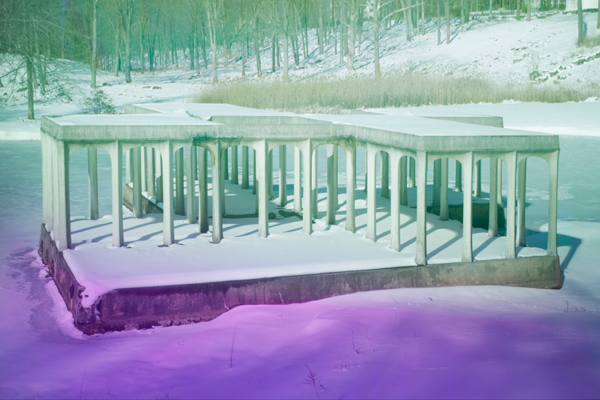Artist:
James Welling (born 1951, Hartford, CT; lives and works in Los Angeles, CA)
Description:
A series of photographs of Philip Johnson’s Glass House, shot with colored filters. For the “Glass House” series, Welling began to use a Canon digital camera and an Epson 9800 printer. The photographs were published in 2011 by Damiani Editore.
“Sylvia Lavin: Your ultimate preference for the Glass House is strikingly in keeping with the postmodernist pleasure in the copy rather than admiration for the original. Not only do you seem to understand the Glass House as a kind of reproduction of the Farnsworth House, you also seem to get close to describing it as a photographic reproduction in particular, as a lens that produces a potentially infinite series of images. In your analysis, the Glass House becomes a proleptic James Welling or James Welling becomes a retroactive manifesto for the Glass House. In this scenario, the Farnsworth House is not a digression, rather it is embedded in a productively critical reading of the Glass House, which is why I’m so interested in hearing you describe the difference between them.
James Welling: Well, I came to the Glass House via Farnsworth, but I quickly saw the Glass House as a complex of structures. Farnsworth is a single pavilion. The Glass House starts out as a pair of buildings, and these multiply into over a dozen structures over time. Still, the Glass House is always the focus when you are in the other buildings.
[…]
Lavin: It was not a house to live in, in the sense that sleeping, for example, generally happened elsewhere. But it was, and still is, a house to be seen, to be seen in, to be disseminated through images, photographs, texts, and TV. When Johnson wrote about the house, he desribed the design as a montage of various historic precedents, like the picturesque landscape, which was not only composed of framed views of the landscape, but was also a producer of the history of architecture in which visitors found Gothic ruins, or Roman temples, or Turkish tents here and there as they promenaded around. The Glass House, too, provides a pictorial understanding of the history of architecture and of the building’s place in that history. Johnson’s Glass House formulates itself as belonging to that history of apparatus-like glass houses, from Chareau’s Maison de Verre to Le Corbusier’s Besteigui apartment, which understand architecture less as providing places to live and more as the structure through which we view the world.
[…]
Lavin: So your images, which record an actual experience or seek to convey the force of authentic experience, provide more intensity than the real view. It’s a fantastic irony that the reproduction of the experience is more concentrated than actually being there, right? […] Or perhaps it’s more deja vu than ironic, since that’s exactly what Johnson did to Mies:” he took the original thing and made it, through the processes of reproduction, into something more than Farnsworth.”
– James Welling, in conversation with Sylvia Lavin, Bologna: Damiani editore, 2011, p.24, p.34, p.37, p.39.



